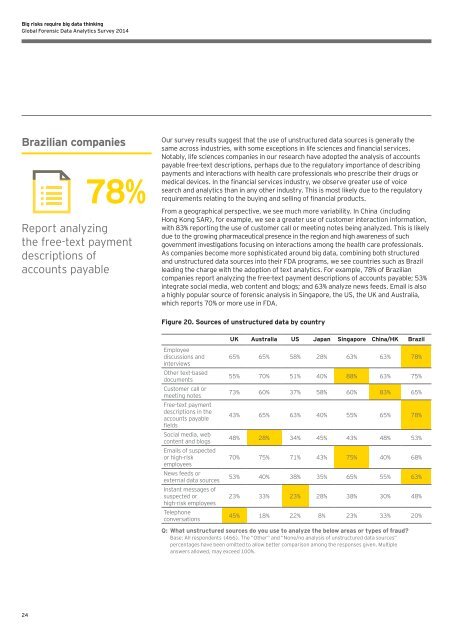EY-Global-Forensic-Data-Analytics-Survey-2014
EY-Global-Forensic-Data-Analytics-Survey-2014
EY-Global-Forensic-Data-Analytics-Survey-2014
Create successful ePaper yourself
Turn your PDF publications into a flip-book with our unique Google optimized e-Paper software.
Big risks require big data thinking<br />
<strong>Global</strong> <strong>Forensic</strong> <strong>Data</strong> <strong>Analytics</strong> <strong>Survey</strong> <strong>2014</strong><br />
Brazilian companies<br />
78%<br />
Report analyzing<br />
the free-text payment<br />
descriptions of<br />
accounts payable<br />
Our survey results suggest that the use of unstructured data sources is generally the<br />
same across industries, with some exceptions in life sciences and financial services.<br />
Notably, life sciences companies in our research have adopted the analysis of accounts<br />
payable free-text descriptions, perhaps due to the regulatory importance of describing<br />
payments and interactions with health care professionals who prescribe their drugs or<br />
medical devices. In the financial services industry, we observe greater use of voice<br />
search and analytics than in any other industry. This is most likely due to the regulatory<br />
requirements relating to the buying and selling of financial products.<br />
From a geographical perspective, we see much more variability. In China (including<br />
Hong Kong SAR), for example, we see a greater use of customer interaction information,<br />
with 83% reporting the use of customer call or meeting notes being analyzed. This is likely<br />
due to the growing pharmaceutical presence in the region and high awareness of such<br />
government investigations focusing on interactions among the health care professionals.<br />
As companies become more sophisticated around big data, combining both structured<br />
and unstructured data sources into their FDA programs, we see countries such as Brazil<br />
leading the charge with the adoption of text analytics. For example, 78% of Brazilian<br />
companies report analyzing the free-text payment descriptions of accounts payable; 53%<br />
integrate social media, web content and blogs; and 63% analyze news feeds. Email is also<br />
a highly popular source of forensic analysis in Singapore, the US, the UK and Australia,<br />
which reports 70% or more use in FDA.<br />
Figure 20. Sources of unstructured data by country<br />
UK Australia US Japan Singapore China/HK Brazil<br />
Employee<br />
discussions and<br />
interviews<br />
Other text-based<br />
documents<br />
Customer call or<br />
meeting notes<br />
Free-text payment<br />
descriptions in the<br />
accounts payable<br />
fields<br />
Social media, web<br />
content and blogs<br />
Emails of suspected<br />
or high-risk<br />
employees<br />
News feeds or<br />
external data sources<br />
Instant messages of<br />
suspected or<br />
high-risk employees<br />
Telephone<br />
conversations<br />
65% 65% 58% 28% 63% 63% 78%<br />
55% 70% 51% 40% 88% 63% 75%<br />
73% 60% 37% 58% 60% 83% 65%<br />
43% 65% 63% 40% 55% 65% 78%<br />
48% 28% 34% 45% 43% 48% 53%<br />
70% 75% 71% 43% 75% 40% 68%<br />
53% 40% 38% 35% 65% 55% 63%<br />
23% 33% 23% 28% 38% 30% 48%<br />
45% 18% 22% 8% 23% 33% 20%<br />
Q: What unstructured sources do you use to analyze the below areas or types of fraud?<br />
Base: All respondents (466). The “Other” and “None/no analysis of unstructured data sources”<br />
percentages have been omitted to allow better comparison among the responses given. Multiple<br />
answers allowed, may exceed 100%.<br />
24


